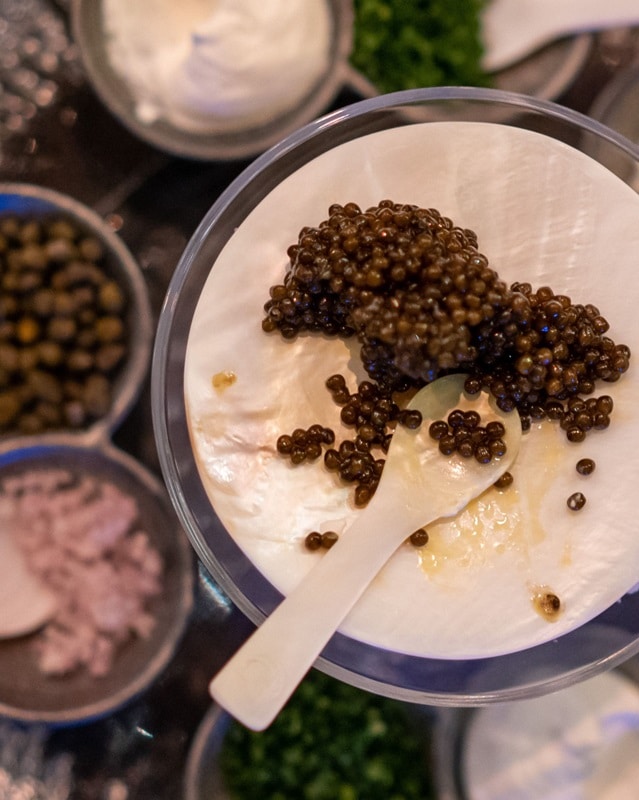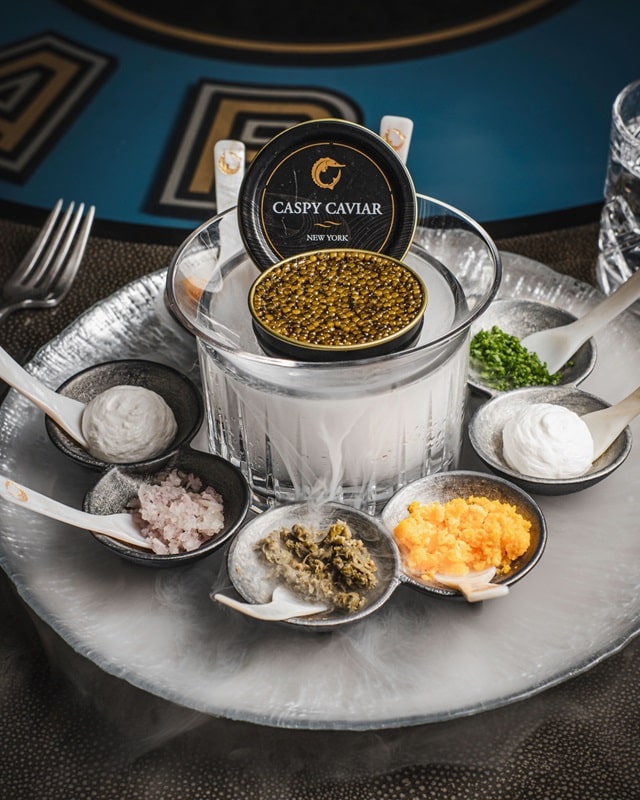Seafood 101:
Caviar Terminology
Caviar has been considered a prized delicacy for centuries, often associated with luxury and indulgence. As one of the most expensive foods in the world, caviar is often reserved for special occasions and celebrations.
But these days, especially with the rise of sustainable farming practices, caviar is becoming more accessible and affordable for everyday consumption. As more people discover its unique and complex flavors, it’s important to understand the terminology used to describe different types of caviar.
We at Aqua Seafood and Caviar Restaurant want to help demystify these terms so you can more confidently and knowledgeably explore the world of caviar.
So, let’s dive into some common terms you may encounter when browsing a caviar menu or shopping for caviar.
Types of caviar
Caviar, the jewel of the culinary world, comes in many forms. Each type has its own unique flavor, texture, and color palette that makes it a masterpiece on the plate. Let’s explore some of these exquisite varieties.

Caviar
Let’s start by defining the word itself. This term is a catch-all for the lightly salt-cured roe from any sturgeon. Caviar is made by gently rubbing the eggs through a sieve to separate them from their membrane.
Aquaculture
Aquaculture is the practice of farming fish and other aquatic species in controlled environments. With the decline of wild sturgeon populations, aquaculture has become increasingly important for sustainable caviar production.
Enjoy seafood and more on the Vegas Strip.
Black caviar
Picture a canvas of midnight velvet studded with pearls. That’s Black caviar for you. It’s derived from the Beluga sturgeon, a giant fish found in the Caspian Sea. The eggs are large, smooth, and have a creamy, slightly salty taste. Imagine popping one into your mouth and experiencing a burst of oceanic flavors.
Bowfin roe
Ever seen a bowl of tiny, glistening black jewels? That’s Bowfin roe, a caviar substitute from the Bowfin fish native to North America. It’s crunchy with a mildly tangy taste. Imagine biting into a pearl that releases a wave of fresh, fishy tanginess.
Caspian caviar
Imagine a treasure chest unearthed from the depths of the Caspian Sea. That’s Caspian caviar, sourced from three types of sturgeon: Beluga, Osetra, and Sevruga. Each type has a distinct flavor and texture, but they all share a rich buttery taste. It’s like tasting a piece of the sea itself, smooth and indulgent.
Fresh caviar
Think of a morning sea breeze carrying the fresh scent of the ocean. That’s fresh caviar! It’s roe that has been recently harvested and minimally processed to retain its original flavors. The eggs are firm, popping delightfully in your mouth to release a burst of fresh, briny goodness.
Golden Osetra caviar
Imagine the sun setting over the sea, casting a golden glow on the waters. That’s Golden Osetra caviar! Sourced from the rare albino Osetra sturgeon, this caviar has a unique nutty flavor and a beautiful golden hue. Each egg is like a drop of liquid gold, rich and full of depth.
Roe
Roe refers to the mass of tiny eggs found inside a female fish. It’s an essential component of caviar, with its texture and flavor adding a unique element to the dish.
What is caviar roe called?
Caviar is a delicacy made from the roe, or fish eggs, of the sturgeon family. This makes it a specific kind of roe that has been cured, which involves adding salt for preservation and flavor.
While roe can come from any fish species, the term “caviar” is exclusively used for the roe of sturgeon fish.
Some non-caviar roe include:
- Salmon roe, often used in sushi and known as “ikura”
- Trout roe, also popular in sushi and known as “tobiko”
- Whitefish roe, a common ingredient known as “masago”
In essence, all caviar is roe, but not all roe qualifies as caviar. It’s important to note that traditional caviar refers only to roe from wild sturgeon in the Caspian and Black Seas, including Beluga, Osetra, and Sevruga caviars.
Why is sturgeon caviar so expensive?
Caviar’s high price tag is due to several factors. First, sturgeon are slow-growing and late-maturing fish, meaning it can take up to 20 years for a female sturgeon to produce roe. Additionally, sturgeon are now critically endangered in the wild, making their roe even more precious.
Furthermore, the process of harvesting and curing caviar is labor-intensive and requires a high level of skill. The roe must be carefully extracted, washed, sorted, and salted to create the perfect balance of flavor, texture, and freshness.
Indulge in culinary excellence at Aqua Seafood & Caviar Restaurant

So there you have it, a tour of the beautiful world of caviar. Each type is a culinary masterpiece waiting to be savored, from the dark Black Caviar to the radiant Golden Osetra.
Aqua Seafood & Caviar Restaurant is the perfect place to experience these delicacies. Located on the Vegas Strip, our restaurant offers a wide variety of caviar dishes for you to indulge in. Along with caviar, we also serve an array of fresh seafood options prepared by our expert chefs.
Come join us for dinner and experience the symphony of flavors that only caviar can offer.
Sources:
rving, L. (2023). The Sustainable Future Of Caviar Harvesting.
Martin, K. (2022). What Makes Caviar So Expensive?
McHugh, T. (2020). How Caviar Is Processed.
